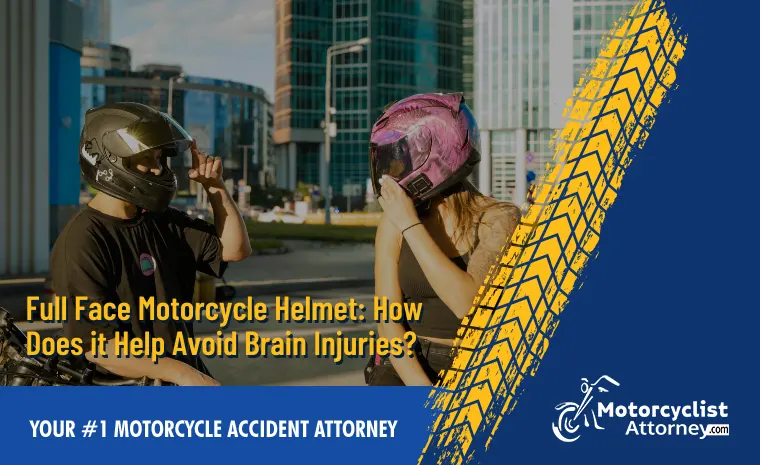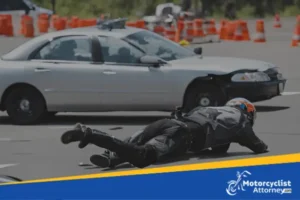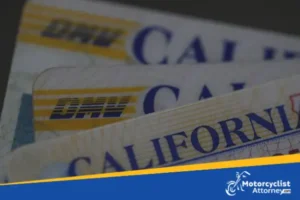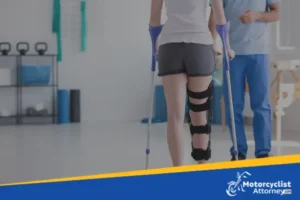Full Face Motorcycle Helmet: How Does it Help Avoid Brain Injuries?
With a lively community, motorcycle-friendly laws and regulations, motorcycling is popular in California. With welcoming highways and frequent traffic jams, it may not be surprising to learn that safety and security are an important part of its riding culture. And that goes beyond the vehicle itself, down to the acceptable tools and precautions a rider must have to enjoy a ride through the city.
Full-face motorcycle helmets, for example, are a legal requirement for all motorcycle riders. The California Vehicle Code (CVC) mandates that all motorcycle riders wear helmets that meet specific safety standards, in compliance with the U.S. Department of Transportation (DOT) regulations, which full-face helmets typically meet.
California’s helmet law is quite strict, and it applies to both riders and passengers, regardless of age or driving experience. Failure to wear an approved helmet can result in severe fines and penalties, as well as risk your physical well-being. It’s important for motorcycle riders in California to not only wear helmets but also ensure they meet the required safety standards.
In this blog, we’ll discuss full-face motorcycle helmets, how they protect you from traumatic brain injuries, and the legal regulations around them, and some guidance to find the best motorcycle accident legal representation in the state of California.
What is a Full-Face Motorcycle Helmet?
This type of advanced head protection is designed exclusively for motorcycle riders. It encompasses the entire head and face, providing an aerodynamic design and comprehensive protection in the event of a crash or accident. The outer shell of a full-face helmet is typically constructed from strong and common materials like fiberglass or polycarbonate, serving as the first line of defense against impacts and abrasions.
One of their key features is the built-in face shield or helmet visor, which covers the rider’s eyes and face. This shield protects the eyes from wind, debris, insects, and the elements. It also acts as a barrier against direct impacts while maintaining a clear field of vision for the rider. These types of helmets should include a chiseled chin bar that extends down to cover the rider’s chin and jaw, providing protection for the lower part of the face and helping prevent facial injuries in the event of a crash.
These helmets meet safety standards set by organizations like the Department of Transportation (DOT) in the United States or the European ECE 22.05 standard. Compliance with these standards ensures that the helmet has passed rigorous safety tests and is designed to provide substantial protection in various crash scenarios, which are sadly common in the roads of California.
Nevertheless, full-face helmets are renowned for their superior protection compared to cheaper motorcycle helmets, making them a popular choice among sportbike riders, racers, and those seeking the highest level of protection and safety. When choosing a full-face motorcycle helmet, it’s important to select one that fits comfortably, meets safety and legal standards, and suits your riding style and preferences.
Injured on a motorcycle accident that wasn’t your fault?
How Full-Face Motorcycle Helmets Prevent Brain Injuries
One of the biggest reasons behind the obligatory nature of full-face motorcycle helmets in California is their design and levels of protection, which are meant to provide comprehensive protection for riders. They play a crucial role in helping to avoid traumatic brain injuries (TBIs) in the event of an accident, offering the following safety features to any rider:
Head and Skull Protection
Full-face helmets with chin bars cover the entire head and the lower part of the face, including the chin and jaw. In the event of a crash, they provide a sturdy shell that absorbs and disperses impact forces. This protection prevents direct blows to the skull and minimizes the risk of skull fractures, which often lead to traumatic brain injuries. Make sure to have a comfortable helmet fit to ensure its effectiveness.
Face Shield
Full-face helmets come equipped with a built-in face shield or visor that covers the rider’s eyes and face. The face shield not only protects the eyes from wind, debris, and insects but also acts as a barrier against direct impacts. This usually tinted shield can prevent facial injuries and reduce the chances of a rider being incapacitated by facial trauma, which could indirectly affect the brain.
Impact Absorption
A key safety feature of full-face helmets is having a multi-layered construction with energy-absorbing materials like expanded polystyrene (EPS) foam. These materials are designed to compress and dissipate energy upon impact, reducing the force transmitted to the head and brain, while offering comfort during rides. This absorption of impact energy is crucial in preventing severe injuries and even deaths.
Neck Support
Full-face helmets also provide some degree of neck support, which can help reduce the likelihood of neck injuries. A stable and properly fitted helmet lessens the strain on the neck, preventing the head from twisting or jolting upon impact, which could otherwise lead to spinal cord injuries and severe disabilities.
Reducing Windblast
Riding at high speeds without a helmet or with an open-face helmet can expose the rider to windblast. The force of wind hitting the face and head can cause injury, including concussions. Full-face helmets minimize windblast through adjustable vents, protecting the head from such forces.
Noise Reduction
Excessive wind noise while riding can lead to fatigue and distraction, affecting a rider’s ability to focus. Full-face helmets help reduce noise levels, allowing the rider to maintain their focus on the road and make safe decisions, thus reducing the risk of accidents leading to brain injuries.
In other words, a full-face helmet’s design provides comprehensive protection for the rider’s head and brain. With a combination of impact absorption, facial protection, and secure fit to minimize the risk of traumatic brain injuries, it’s essential for riders to choose a helmet model that meets safety standards and maximize its protective benefits.

Full-Face Motorcycle Helmets in California Law
As mentioned earlier, helmets are legally required by the state of California when riding a motorcycle, ever since the Highway Safety Act of 1966. In specific, the helmets must comply with the U.S. DOT Federal Motor Vehicle Safety Standard (FMVSS) 218, which full-face motorcycle helmets cover perfectly, and a breakdown of these requirements can easily be found in the California DMV handbook website. It should be noted that one of the main reasons behind the legal obligation of a helmet for a motorcycle rider is that, according to the National Highway Traffic Safety Administration, motorcycle helmets reduce the likelihood of traumatic brain injuries by 27%. Furthermore, according to that study, helmets reduce the odds of a TBI in multiple-vehicle crashes by around 40%.
These considerations, then, make clear why choosing to use a full-face motorcycle helmet is critical when navigating the roads of California. With 1,088 crashes resulting in fatalities or severe injuries between 2020 and 2022, the chances of an accident while riding a motorcycle are higher than you may think.
Why Do You Need a California Motorcycle Accident Lawyer?
Wearing a fully compliant helmet is just the first step to ensure your safety on the road. In the event of a crash caused by a negligent party, an attorney who specializes in motorcycle accidents can play a crucial role in the aftermath for several reasons. First and foremost, motorcycle accidents involve distinct factors and challenges, such as lane splitting, limited visibility, and the heightened vulnerability of riders to injury. A specialized attorney understands these and offers tailored guidance.
Moreover, motorcycle accident attorneys possess in-depth knowledge of traffic laws and regulations specific to motorcyclists, critical when assessing the rider’s actions or those of other motorists before the accident. Establishing liability, after all, is a fundamental aspect of any legal case, and a motorcycle accident attorney can conduct a thorough investigation, gather evidence, and assess liability to determine who is at fault.
Dealing with insurance companies is also a complex process, but motorcycle accident attorneys can secure complete coverage or fair compensation for medical expenses, property damage, lost wages, and pain and suffering. They shield the rider’s interests against these companies, maximizing fair compensation as their primary goal. Motorcycle accidents often result in substantial medical bills and long-term consequences, and a good attorney understands this and works diligently to ease the stress and mental load of filling a claim, letting a victim focus on what really matters.
Motorcyclist Attorney is Here to Help
Motorcycle accidents can be emotionally traumatic, and riders may need special support in these difficult times. A motorcycle accident lawyer can offer help, both in legal counseling and emotional reassurance to ensure a victim’s long-term well-being.
This is the specialty of Motorcyclist Attorney. We take prompt action to ensure that you receive the fair compensation you deserve after a crash caused by other people’s negligence, offering the experience of all of our motorcycle accident specialists when dealing with these matters. At Motorcyclist Attorney we work on a contingency fee basis, meaning you don’t need to pay us a single cent unless we win. This relieves you of any financial burden so you can focus on your recovery.Call us today at (844) 284 9437 for a free consultation. When it comes to motorcycle accidents, every second counts, so choose the best advocate for your rights.




